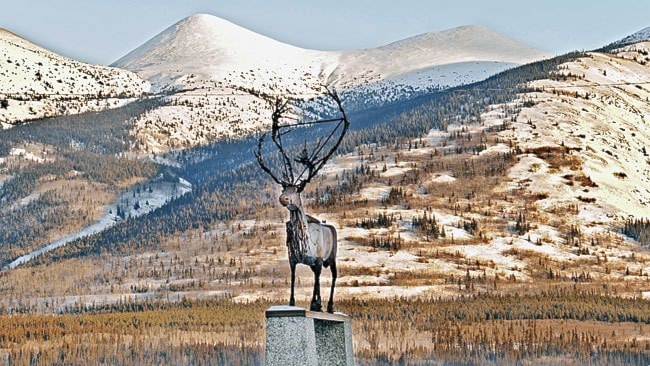Fostering economic development is almost a cliche in many of the Yukon's rural communities.
Carcross, however, seems to have figured it out. At least Justin Ferbey hopes so.
Ferbey is the head of the Carcross /Tagish First Nation’s economic arm. He and a half-dozen dignitaries were joined by a crowd of about 50 people for the official opening of the Carcross Commons last Friday. The collection of shops - which feature beautiful Tlingit facades - shares a parking lot with the S.S. Tutshi memorial, and represents the culmination of nearly 40 years of work to build a sustainable economy in Carcross.
“We realized that we had to divest in Whitehorse, which has a mature, thriving economy, and invest in the community, and look at both getting financial viability and equally if not more important, achieving the opportunity for our people to find employment,” Ferbey told the crowd at the opening.
So the community came up with a plan. Montana Mountain was a perfect place for mountain bike trails. With Bennett Lake as a backdrop, even the most amateur photographer can shoot their own Yukon postcard. And the well-preserved Klondike-era character of the town’s general store is a hit with the thousands of trinket-hunting tourists who bus every day from the decks of Skagway cruise ships to Whitehorse.
What the community needed, Ferbey said, was a way to capture the market that already flowed through the town every summer.
“Probably unique to our community is that the old adage, if you build it they will come, we didn’t have to worry about here. Even before this was built we get about 120,000 to 130,000 people coming here a summer. It’s 1,000 people a day,” Ferbey said.
“For us, it was, ‘If we build it will they stay longer?’ We figured yes, they will. It wasn’t a huge risk for us because the volume is already there.”
Now that it is built, he’s betting they will come.
Ferbey was quick to downplay his role in creating the Commons and the larger economic vision.
“My job, as the economic arm of the CTFN, is really just to ultimately do what I’m told. If I was to make a confession, I’d say I have stolen and pilfered the great ideas of others, and at moments like this seem to pass them off as my own. In fact, this community is the one that came up with this vision,” Ferbey said.
But if he didn’t father the ambitious plan, he definitely helped birth it.
“Governments of the day come and go,” said CTFN Chief Danny Cresswell.
“The leadership, there was so much emphasis put on the land claims process that this stuff just ended up on the back burner. Thankfully, there are some people who have been able to talk about it and pull it off that back burner and put it back in the forefront.”
“Justin believed in the vision and the bigger picture,” said Yukon MP Ryan Leef, speaking on behalf of the Canadian Northern Economic Development Agency, which contributed nearly $400,000 to the $520,000 scheme, with the First Nation carrying the rest.
“It must be incredibly rewarding to see the work that you put in with your friends, colleagues, your family and this community,” Leef said.
All retail spaces have been rented, and the new tenants are already moving in. Caribou Coffee is already open and there will also be a smoked salmon shop.
Frank Deramo, an American businessman from Skagway, is going to open Carcross’s first pizza shop, called Gold Pan Pizza.
“Justin and I have been talking about it and negotiating for quite a while,” Deramo said. “I believe I’m the only U.S. citizen in here.
“He worked pretty hard on this. It’s been a learning experience for him and for everybody. A lot of issues came up having to do with construction and cost that surprised people, but we came through it.”
“I taught in native villages with the Navajo down south for 23 years. This is the most impressive visually, of any native thing I’ve seen. As far as a commercial place, the artwork on the front and back of these buildings is just tremendous,” Deramo said.
But getting here wasn’t an easy feat, Ferbey said. There were some bumps along the way, and construction of the retail village proved more expensive than planned, especially having to hire builders to drive out from Whitehorse.
While the ceremony had all the pomp and circumstance of a job well done, Ferbey knows that it will take a couple of years at least to know whether the expensive gamble was worth it.
“We’re going to find out. The biggest thing from our perspective is that is has to be market driven. We had to realize that this is a mid-term investment. For the first few years, it will provide positive cash flow, but it will take time for the concept to be proved out and the rents to start to rise. In essence we had to have a threshold for risk as investors, and we found investors to help us mitigate some of the risk,” Ferbey said.
Along with the federal CanNor money, Northern Vision Development contributed to the project, as did the Yukon government.
Ferbey is confident that the Commons will work - so confident, in fact, that he’s still planning further expansion to the plan. He wants to build a multi-million dollar eco-resort and upgrade the facilities along the shore of Bennett Lake.
But getting a return on his community’s financial investment is secondary, Ferbey said.
“The biggest return here is seeing people finally getting jobs and new economic opportunities. One of the most exciting things for me is Frank Deremo putting up a wanted sign for employment. It’s the human benefit, which excites me,” he said.
Contact Jesse Winter at
jessew@yukon-news.com
